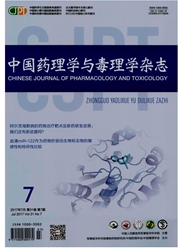

 中文摘要:
中文摘要:
目的探讨程序性坏死(necroptosis)在铝致神经细胞死亡中的作用,以完善铝致神经细胞死亡的机制研究。方法用4mmol·L^-1AlCl3·6H2O染毒神经母细胞瘤细胞SH-SYSY制作铝致神经细胞死亡模型,用RNA干扰技术(RNAi)抑制半胱氨酸天冬氨酸蛋白酶(caspase)3基因的表达;用程序性坏死的特异性阻断剂necrostatin-1(Nec-1)抑制程序性坏死的产生。检测不同处理、处理后不同时间点细胞的活力变化,荧光定量PCR法检测RNAi效率,流式细胞仪检测细胞的凋亡率及坏死率改变,免疫组织化学法检测蛋白表达量的差异。结果通过细胞活力在不同小干扰RNA(siRNA)序列、不同转染剂量、不同作用时间点的变化,找到其最适转染浓度为10nmol·L^-1,最适作用时间为转染后48h。通过RNAi抑制caspase3基因表达的差异,筛选出最有效序列为caspase3 siRNA1序列;荧光染色并观察计数表明caspase3 siRNA的转染效率为93.0%,其干扰效率为63.0%,对caspase3蛋白表达有显著的阻抑效应。Caspase3 siRNA单独作用于染铝SH-SY5Y细胞,可以显著提高细胞活力,降低其凋亡率;Nec-1单独作用于染铝SH-SY5Y细胞可以显著提高其细胞活力,降低细胞坏死率;共同作用在染铝SH—SY5Y细胞时两者有增强作用,可以显著提高细胞活力,并同时降低SH—SY5Y细胞的凋亡率及坏死率。结论在铝致神经细胞死亡的机制中,除了传统上认为的凋亡和坏死途径外,还有程序性坏死的存在。
 英文摘要:
英文摘要:
AIM To investigate whether necroptosis in one of the mechanisms of aluminuminduced cell death. METHODS The alumi-num-induced in vitro cell death model was prepared by treating SH-SY5Y cells with AlCl3 6H20 at 4 mmol· L^-1, RNA interference (RNAi) was performed to suppress the expression of caspase 3 gene, necrostatin-1 ( Nec-1 ) was added into culture to restrain necroptosis. Cell viability was detected at different treatments and diverse time courses after treatment. Interference efficiency was measured by QRTPCR, and apoptotic rate and necrotic rate were measured with cytometry. Finally, level of protein expression was quantified with immunohistochemistry. RESULTS Based on the viability in different caspase 3 RNA small interference ( caspase 3 siRNA ) sequences, transfection concentration and transfection course, we determine the optimal transfection concentration was 10 nmol·L^-1, the optimal transfection time was 48 h after transfection. Furthermore, caspase 3 siRNA 1 was selected as the most effective sequence according to the gene expression of different siRNA sequences, the transfection efficiency was 93.0%, the interference efficiency was 63.0%, and there was also a significant difference in the expression of caspase 3. The cell viability could be improved significantly by caspase 3 siRNA, and the apoptotic rate was re- duced simultaneously. On the other hand, the viability could be enhanced significantly by Nec- 1, and the necrotic rate decreased. Cooperation of caspase 3 siRNA 1 and Nec-1 could increase the cell viability significantly, and both apoptotic rate and necrotic rate were enhanced. CONCLUSION Necroptosis is presented in the cell death pathway of aluminum induced cell death, besides apoptosis and necrosis.
 同期刊论文项目
同期刊论文项目
 同项目期刊论文
同项目期刊论文
 期刊信息
期刊信息
